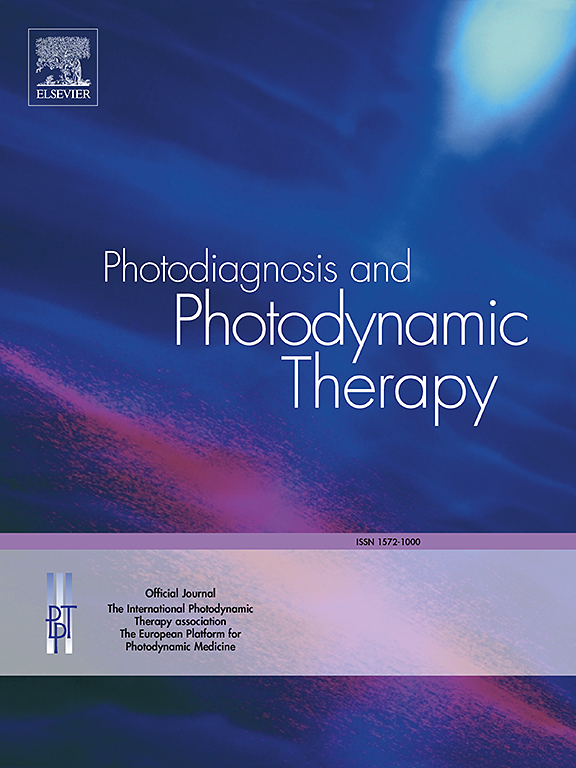评估 Hemoporfin-PDT 治疗曾接受过 PDL 治疗的幼儿 PWS 胎记的疗效。
IF 3.1
3区 医学
Q2 ONCOLOGY
引用次数: 0
摘要
背景:Hemoporfin介导的光动力疗法(Hemoporfin-PDT)被认为是一种安全有效的治疗葡萄酒色斑(PWS)的方法。本研究旨在调查脉冲染料激光(PDL)治疗史对Hemoporfin-PDT治疗1-3岁PWS患儿疗效的影响:收集接受过两次或两次以上Hemoporfin-PDT治疗的1-3岁PWS患者的数据。研究对象分为两组:组群 1(无 PDL)包括无 PDL 治疗史的患者,而组群 2(既往 PDL)包括有 PDL 治疗史的患者。研究人员对疗效与性别、年龄、发病部位、PWS类型等变量之间的关系进行了分析:无 PDL 组共有 220 例,PDL 前治疗组共有 53 例。据观察,既往PDL治疗史并不影响Hemoporfin-PDT治疗幼儿PWS的疗效。PWS的类型和部位对Hemoporfin-PDT治疗PWS的临床疗效有显著影响(P=0.040,P0.05)。值得注意的是,面部周围可能是面部区域 Hemoporfin-PDT 疗效高的一个独立影响因素(PConclusion:既往PDL治疗史不会影响Hemoporfin-PDT治疗PWS患儿的疗效。本文章由计算机程序翻译,如有差异,请以英文原文为准。
Evaluation of efficacy of Hemoporfin-PDT in the treatment of PWS birthmarks of young children previously received PDL treatment
Background
Hemoporfin-mediated photodynamic therapy (Hemoporfin-PDT) is considered a safe and effective treatment for port-wine stains (PWS). This study aims to investigate the influence of prior pulse dye laser (PDL) treatments history on the effectiveness of Hemoporfin-PDT in young children aged 1–3 years with PWS.
Methods
Data was gathered for individuals with PWS aged 1–3 years who received two or more Hemoporfin-PDT treatments. The study population was stratified into two groups: Cohort 1 (No PDL) comprised patients without a history of PDL treatment, while Cohort 2 (Prior PDL) consisted of patients with a history of PDL treatment. An analysis was conducted to investigate the relationship between treatment efficacy and variables including gender, age, location, and type of PWS.
Results
There were a total of 220 cases in the No PDL group and 53 cases in the Prior PDL group. It was observed that prior PDL treatment history did not impact the efficacy of Hemoporfin-PDT in treating PWS among young children. Both the type and location of PWS significantly influence the clinical effectiveness of Hemoporfin-PDT for PWS (P = 0.040, P < 0.001), while gender and age show no association with treatment outcomes (P > 0.05). Notably, the peripheral face might be an independent influencing factor for high efficacy of Hemoporfin-PDT of the facial regions (P < 0.05).
Conclusion
Previous PDL treatment history does not impact the effectiveness of Hemoporfin-PDT therapy in young children with PWS.
求助全文
通过发布文献求助,成功后即可免费获取论文全文。
去求助
来源期刊

Photodiagnosis and Photodynamic Therapy
ONCOLOGY-
CiteScore
5.80
自引率
24.20%
发文量
509
审稿时长
50 days
期刊介绍:
Photodiagnosis and Photodynamic Therapy is an international journal for the dissemination of scientific knowledge and clinical developments of Photodiagnosis and Photodynamic Therapy in all medical specialties. The journal publishes original articles, review articles, case presentations, "how-to-do-it" articles, Letters to the Editor, short communications and relevant images with short descriptions. All submitted material is subject to a strict peer-review process.
 求助内容:
求助内容: 应助结果提醒方式:
应助结果提醒方式:


